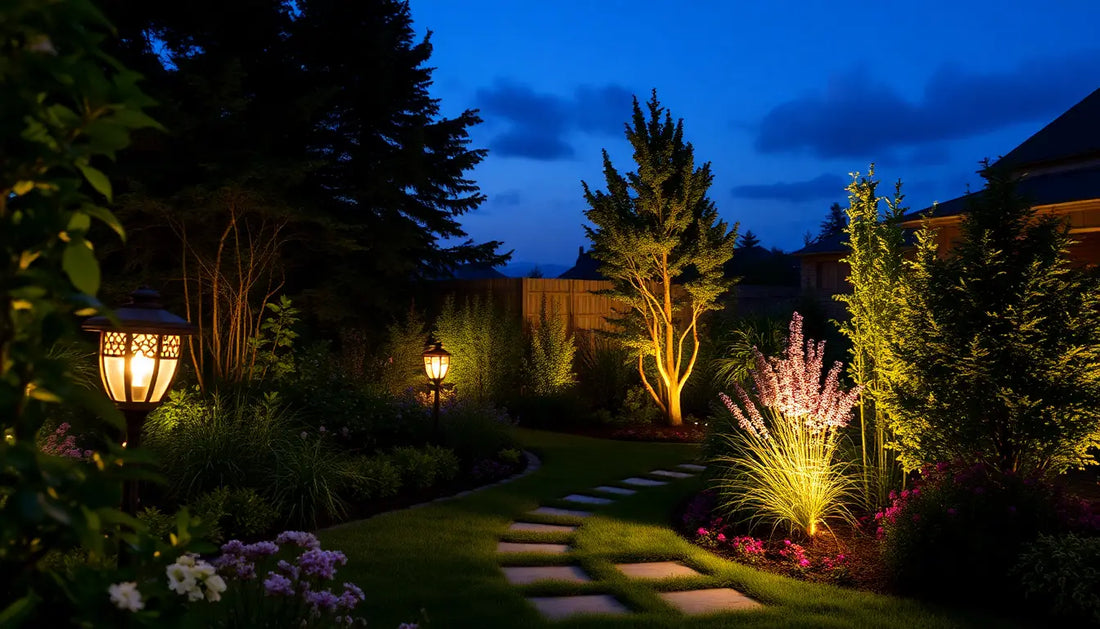
Solar vs. Traditional Outdoor Lighting for Gardens: What's Best?
Share
Comparison of Solar vs. Traditional Outdoor Lighting for Gardens
Introduction
Outdoor lighting plays a significant role in enhancing the beauty and functionality of gardens. Whether you're entertaining guests or creating a cozy atmosphere for evening strolls, the right lighting can make all the difference. In this blog post, we'll explore the best outdoor lighting for gardens, focusing on a comparison between solar garden lights and traditional outdoor lighting.
Understanding Outdoor Lighting Options
Solar Garden Lights
Solar garden lights are an innovative solution that harnesses the power of the sun. These lights typically consist of a solar panel, LED bulb, and battery. During the day, the solar panel charges the battery, allowing the light to shine at night. Some key features of solar garden lights include:
- Energy independence: As they're powered by the sun, they reduce electricity costs and environmental impact.
- Easy installation: Most solar lights require minimal setup; just place them where needed!
- Variety of styles: Solar lights come in various designs, making it easy to find options that complement your garden’s aesthetic.
Traditional Outdoor Lighting
Traditional outdoor lighting typically relies on wired electricity and often includes incandescent, halogen, or LED lights. They are commonly installed along pathways, around patios, or to spotlight garden features. The key features of traditional outdoor lighting are:
- Consistent brightness: They often provide higher luminosity, ensuring well-lit areas.
- Variety of options: There are many styles and types available, including wall-mounted fixtures and post lights.
- Dependable performance: Traditional lighting works regardless of weather, making it a reliable choice.
Energy Efficiency and Environment
Solar Lighting and Sustainability
One of the main advantages of solar garden lights is their environmentally friendly lighting options. They do not rely on non-renewable energy sources, which reduces your carbon footprint. Solar lights are also energy efficient because they use LED bulbs, which consume less power. This means you save energy while enjoying a beautifully lit garden.
Traditional Lighting Energy Consumption
On the other hand, traditional outdoor lighting often consumes a significant amount of electricity. Depending on the type of bulb used—especially incandescent—these options can lead to higher energy bills. Additionally, reliance on non-renewable sources raises concerns about environmental impact. The need for ongoing electricity makes traditional lighting less sustainable over time.
Cost Comparison
Initial Investment
When considering the upfront cost, solar garden lights can initially cost more due to the integrated solar technology. However, prices are dropping as technology advances. Traditional outdoor lighting typically requires less initial investment for basic setups. However, the installation costs can add up when factoring in wiring and labor.
Long-term Savings
In the long run, solar lights usually provide greater financial benefits. They do not incur electricity costs, and maintenance tends to be lower since they have fewer components that can fail. Conversely, traditional lighting involves recurring electricity expenses and potential bulb replacements, leading to higher overall costs.
Brightness Comparison Outdoor Lights
Understanding Lumens and Brightness
Lumens measure the brightness of lights. When choosing the best outdoor lighting for gardens, it's crucial to consider how much light you need in different areas. For path lighting, a lower lumens rating is acceptable, while areas that require more visibility, like patios, might need lights with higher lumens.
Brightness of Solar vs. Traditional Options
Solar garden lights typically offer lower brightness levels compared to traditional outdoor lighting. This might make them less suitable for illuminating large areas. However, advancements in technology have created brighter solar options that work well in certain situations, particularly if designed specifically for outdoor use.
Installation and Maintenance
Installation of Solar Garden Lights
One of the appealing aspects of solar garden lights is their easy installation process. They usually require no wiring; just stake them into the ground or set them in place, and you’re done.
Installation of Traditional Outdoor Lighting
Traditional lighting, while often more powerful, can be challenging to install. Wiring, electrical knowledge, and sometimes a professional electrician might be necessary, which increases costs and complexity.
Maintenance Requirements
For solar lights, maintenance typically involves cleaning the solar panels and replacing batteries every few years. In contrast, traditional lights may require regular bulb replacements and more frequent electrical checks, adding to your workload.
Aesthetic Considerations
Design and Style
Both solar and traditional lights come in various designs. Solar garden lights often lean towards a more modern, eco-friendly aesthetic while offering a range of styles like fairy lights or lanterns. Traditional lighting often includes classic designs, such as lanterns or sconces, that blend vintage charm with functionality. When choosing lighting, consider how each style complements the overall design of your garden.
Creating Ambiance
Lighting impacts how a garden feels at night. Solar garden lights can give a soft, whimsical vibe, perfect for casual gatherings. Traditional outdoor lighting tends to be brighter and can create a more formal atmosphere, ideal for entertaining.
Conclusion
In summary, both solar garden lights and traditional outdoor lighting offer unique benefits. Solar lights are generally more energy-efficient and environmentally friendly. Traditional options provide higher brightness and reliability. Ultimately, the best outdoor lighting for gardens depends on your personal needs, budget, and aesthetic goals. Consider what best suits your garden and lifestyle to make the right choice!
